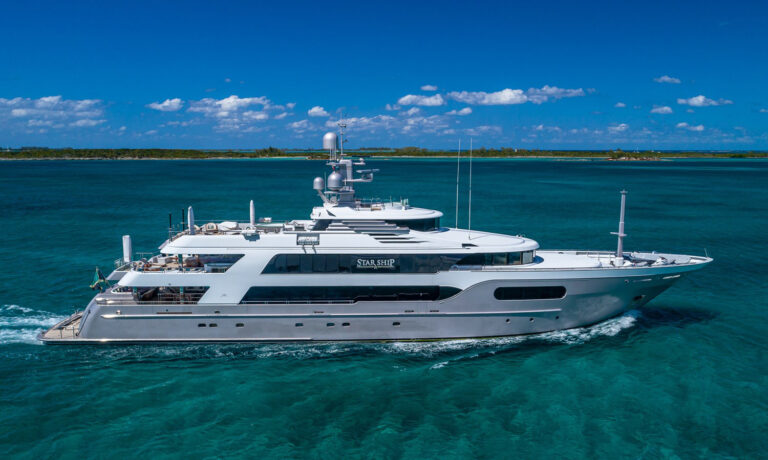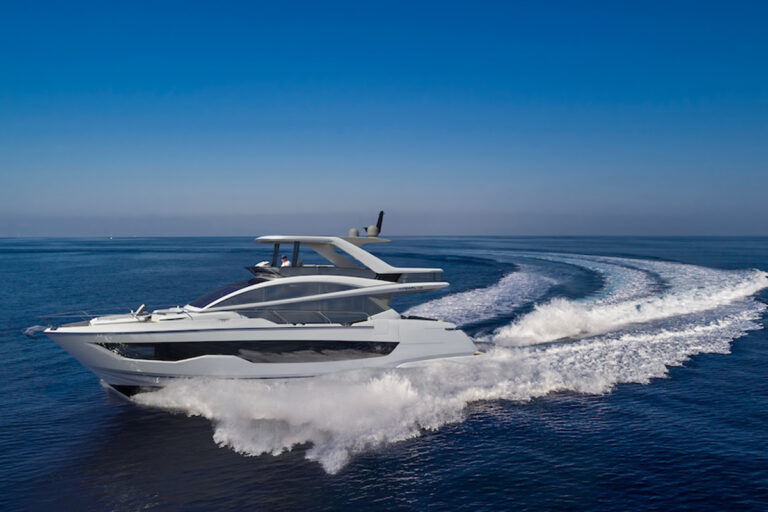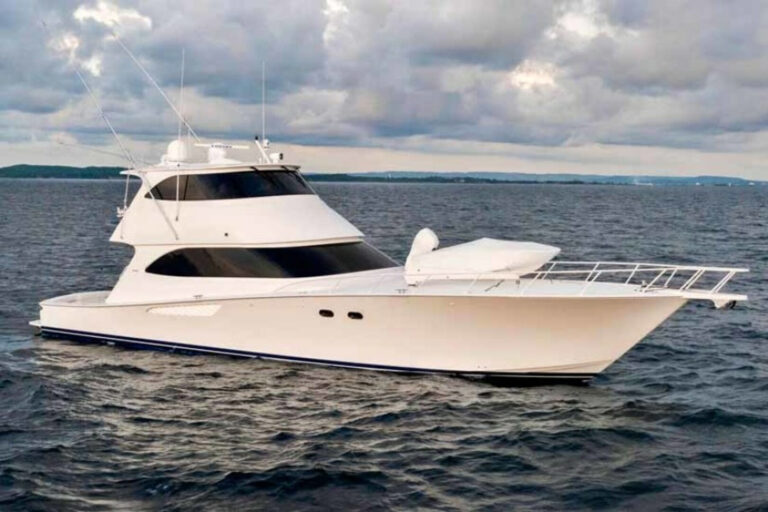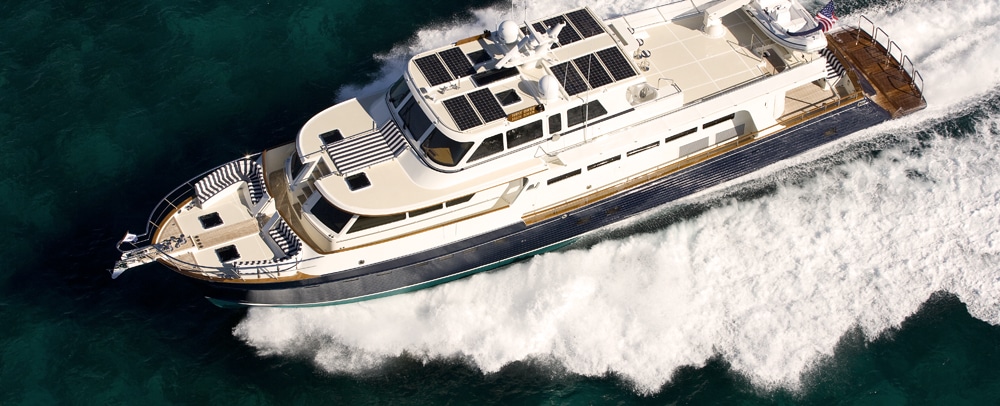
Solar Panels Main
Although the economics of large-scale solar-energy projects for commercial or residential installations continue to be a challenge and solar-hybrid-powered boats have proved to be overly complex and expensive, many power and sailing vessels can benefit greatly from the use of solar energy to help manage their electrical power requirements. Solar panels help charge the house batteries while anchored or sitting on a mooring, reducing or eliminating the need to run the generator. Several boatbuilders now offer marine solar panels as options or standard equipment, and owners of older boats are adding solar panels to the charging systems.
The simplest system for a small outboard-powered boat that you may have tugging on a mooring consists of connecting a removable, often flexible, solar panel directly to the boat’s battery. This can help keep the battery charged to ensure that a bilge pump will function and that the engine will start after being left unattended for an extended time. These small units cost less than $100 and typically put out less than one amp during maximum sunlight, thereby not requiring an external charger/controller to prevent overcharging. They simply keep the boat’s battery topped off and are not designed to provide energy to power the vessel’s electrical accessories.
Permanently mounted marine high-output marine solar panels can be a significant source of power on larger vessels. Before choosing any panels or associated equipment you first need to determine exactly what you’re trying to accomplish, how much of an electrical load you expect the solar system to satisfy, and whether you need to modify other components of your vessel’s electrical system. There’s a huge difference between providing enough energy to run a few DC fans and lights at night versus keeping a household-size, 110-volt refrigerator running through a DC-AC inverter fed by a large house battery bank.
_See more images of onboard solar installation._
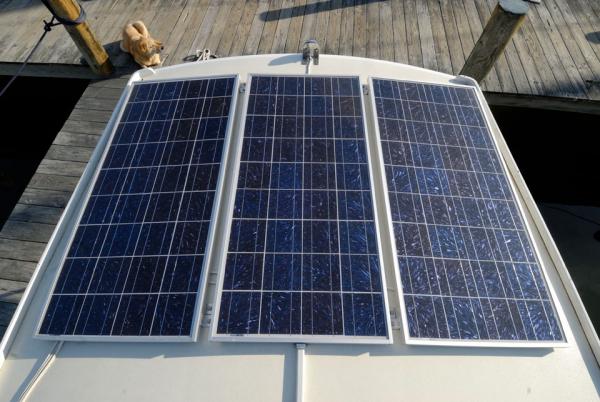
High-output marine solar panels are connected to a charger/controller to ensure the proper charge level of your house battery bank. The size of this bank, in ampere-hour (Ah) capacity, determines which appliances you can run for a certain amount of time. To determine your daily energy requirement, find the current draw of each appliance at 12-volt DC (or 24-volt DC if your boat is so equipped), estimate how long each will run during a 24-hour period and arrive at a daily amp-hour requirement. West Marine provides a handy “electrical budget worksheet” on its website.
Instead of amp-hour ratings, you can also determine your energy needs measured in watts by multiplying the voltage times the current. A 12-volt DC refrigerator compressor that draws four amps computes to 48 watts. Of course, remember to estimate how long each appliance runs per day. My 12-volt DC Frigoboat refrigerator, which draws 3.5 amps, is well insulated and runs about 20 minutes every hour, so its daily requirement is 28 Ah or 336 watts.
On my 43-foot powerboat, running the refrigeration system and occasionally using the inverter to run a microwave oven, satellite TV system and a modest amount of lighting and electronics, I use 125 to 150 Ah per day. My house battery bank is 900 Ah, and while that sounds like a lot, remember that you can use only about half of your battery capacity before recharging is necessary. Also consider that the last 15 percent of a recharge takes a long time, so it’s more practical to figure on having 85 percent of that 50 percent capacity available. The math tells me that I have about 382 Ah to use before recharging — about three days of energy with modest use.
My goal for installing a solar array was to gain another two or three days of energy, allowing me to anchor out for five days or more before I have to run the main engine to recharge. (I choose not to have a generator.) My extended cockpit rooftop was the ideal location for three permanently mounted solar panels that generate about seven amps each during maximum sunlight — about five to six hours a day. Each of these 130-watt panels measures 60 inches by 26 inches. They are connected to a 25-amp charger/controller, which is integrated into the electrical system. A Link monitor tells me how much energy I’m using and how many amp-hours remain stored in my house battery bank. So I am refilling my battery bank by 21 amps, less the number of amps I am currently using. The panels also provide a modest output a couple of hours before and after maximum sunlight, so on a sunny day I can fill my battery bank with about 100 Ah while using 150 Ah, for a net loss of 50 Ah per day. Based on my 382 Ah usable capacity (out of 900 Ah), I can now stay on the hook for seven days. On cloudy or rainy days, the solar panels generate far less energy and I have to rely on my engine and high-output alternator to recharge my battery bank.
When deciding where to install your solar panels, keep them away from the radar dome, flagstaff and other structures that would cast a shadow on their surfaces. Even a small shadow significantly reduces power output. Popular locations include the hardtop, Bimini top, radar arch, coachroof and deck. You’ll want to be able to reach them for routine cleaning, since dust and dirt lowers their output. Heat also degrades solar-panel output, so it’s important to provide air circulation under them. Most solar panels use either a monocrystalline or multicrystalline cell and have a tempered glass surface, which you cannot walk on. SunWare, a German manufacturer, makes a lower-profile unit that can tolerate limited, light foot traffic and does not require air circulation underneath.
You can mix and match different sizes of panels to maximize the overall solar footprint as long as they are of the same voltage. Just be sure that the charger/controller can handle the total output of your array of panels. When designing the system, it’s better to err on the high side, fitting as many panels as you can in the allotted space. Several days of cloudy or overcast weather can seriously diminish the system’s output, as will a lower angle of the sun at certain times of the year.
When selecting a system, you’ll want to carefully consider all of its components to maximize performance and efficiency. Large battery banks require robust chargers, and an AC generator and/or a high-output alternator governed by a smart regulator ensures rapid, efficient recharging when your boat isn’t plugged into shore power. A digital battery monitor keeps track of power usage, charge rates and stored energy levels. Without such a device, you’ll be in the dark guessing whether your batteries will last through the night. Xantrex and Blue Sea Systems offer good, reasonably priced units.
The prices of high-quality, marine-grade solar panels have actually stabilized. Typically, 130-watt panels that measure 60 inches by 26 inches cost between $700 and $800 each — 75-watt units cost about $500. A 30-amp charger/controller is around $100. Today, the parts for a 390-watt system like mine — three large panels and a charger/controller — would cost about $2,500. Depending on the complexity of the installation, you can probably figure on spending at least that amount for the labor to properly install and connect the system.
For roughly $5,000, I’m able to generate enough electrical power to run the appliances on my boat (except the water heater and air-conditioner) for about a week anchored out in sunny or partly sunny weather. After the initial investment, the sun’s energy is free, but the biggest advantages are silence, absence of moving parts and no maintenance. With warranties of 20 years or more on today’s better solar panels, this is one green initiative that makes economic sense.





